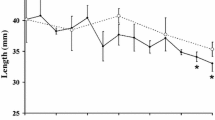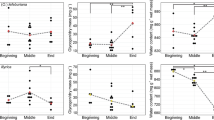Abstract
When the Arctic hyperiid amphipod Themisto libellula was starved for a month the lipid and energy content decreased. Over the first two weeks 5.50 μg lipid and 0.24 joules were consumed per mg dry weight·d, but rates of lipid and energy consumption decreased by 70–75% during the subsequent two weeks. An individual with maximum lipid reserve could survive for about 168 days without food. Given that lipid is also needed for reproduction in mid-winter, it seems unlikely that animals could overwinter without feeding. Temperatures between 0° and 6° C had only a slight effect (Q10 = 1.61) on the rate of lipid and energy consumption. The effect of temperatures in the normal habitat range on the rate of respiratory metabolism was also small (Q10 = 2.01), but above 5°C the rate increased sharply (Q10 = 6.5). Starvation for 15 days had no significant effect on the animals' metabolic rate.
Similar content being viewed by others
References
Aldrich JC (1975) Individual variability in oxygen consumption rates of fed and starved Cancer pagurus and Maia squinado. Comp Biochem Physiol 51A:175–183
Bamstedt U (1981) ETS activity as an estimator of respiratory rate of Zooplankton populations. The significance of variations in environmental factors. J Exp Mar Biol Ecol 42 (3):267–283
Bamstedt U, Tande KS, Nicolajsen H (1985) Ecological investigations on the Zooplankton community of Balsfjorden, northern Norway: Physiological adaptations in Metridia longa (Copepoda) to the overwintering period. In: Gray JS, Christiansen ME (eds) Marine Biology of polar regions and effects of stress on marine organisms. John Wiley and Sons Ltd, pp 313–327
Barclay MC, Dali W, Smith DM (1983) Changes in lipid and protein during starvation and the moulting cycle in the tiger prawn, Penaeus esculentus Haswell. J Exp Mar Biol Ecol 68:229–244
Bradstreet MSW, Cross WE (1982) Trophic relationships at high Arctic ice edges. Arctic 35 (sn1):1–12
Brody S (1945) Bioenergetics and growth. Hafner Publishers, NY, 1023 pp
Carpenter JH (1965) The Chesapeake Bay Institute technique for the Winkler dissolved oxygen method. Limnol Oceanogr 10:141–143
Conover RJ (1962) Metabolism and growth in Calanus hyperboreus in relation to its life cycle. Rapp Proc-verb Cons Int Explor Mer 153:190–197
Conover RJ (1964) Food relation and nutrition of Zooplankton. Proc Symp Exp Mar Ecol, Univ Rhode Island, Occas Publ 2:81–91
Dunbar MJ (1942) Marine macroplankton from the Canadian eastern Arctic. 1. Amphipoda and Schizopoda. Can J Res 20D:33–46
Dunbar MJ (1946) On Themisto libelluta in Baffin Island coastal waters. J Fish Res Board Can 6 (sn6):419–434
Dunbar MJ (1957) The determinants of production in northern seas: a study of the biology of Themisto libellula Mandt. Can J Zool 35:797–819
Elendt B-P (1989) Effects of starvation on growth, reproduction, survival and biochemical composition of Daphnia magna. Arch Hydrobiol 116 (4):415–433
Folch J, Lees M, Sloane-Stanley GH (1957) A simple method for the isolation and purification of total lipids from animal tissues. J Biol Chem 226:497–509
Gauvin JM, Gardner WS, Quigley MA (1989) Effects of food removal on nutrient release rates and lipid content of Lake Michigan Pontoporeia hoyi. Can J Fish Aquat Sci 46:1125–1130
Grainger EH (1953) On the age, growth, migration, reproductive potential and feeding habits of the arctic char (Salvelinus alpinus) of Frobisher Bay, Baffin Island. J Fish Res Board Can 10 (6):326–370
Grainger EH (1971) Biological oceanographic observations in Frobisher Bay. II. Zooplankton Data, 1967–1970. Fish Res Board Can Tech Rep 266:61 pp
Grainger EH (1989) Vertical distribution of Zooplankton in the Central Arctic Ocean. In: Rey L Alexander V (eds) Proc 6th Conf Comité Arctique Int, EJ Brill Publ, NY, pp 48–60
Hiller-Adams P, Childress JJ (1983) Effects of prolonged starvation on O2 consumption, NH4 + excretion, and chemical composition of the bathypelagic mysid Gnathophausia ingens. Mar Biol 77:119–127
Hirche H-J (1983) Overwintering of Calanus finmarchicus and Calanus helgolandicus. Mar Ecol Progr Ser 11:281–290
Ikeda T (1971) Changes in respiration rate and in composition of organic matter in Calanus cristatus (Crustacea Copepoda) under starvation. Bull Fac Fish Hokkaido Univ 21 (4):280–298
Ikeda T, Dixon P (1982) Body shrinkage as a possible overwintering mechanism of the antarctic krill, Euphausia superba Dana. J Exp Mar Biol Ecol 62:143–151
Larson RJ, Harbison GR (1989) Source and fate of lipids in polar gelatinous Zooplankton. Arctic 42 (4):339–346
Lee RF (1974) Lipid composition of the copepod Calanus hyperboreus from the Arctic Ocean. Changes with depth and season. Mar Biol 26:313–318
Lee RF (1975) Lipids of arctic Zooplankton. Comp Biochem Physiol 518:263–266
Lee RF, Hirota J, Barnett AM (1971) Distribution and importance of wax esters in marine copepods and other Zooplankton. Deep-Sea Res 18:1147–1165
Linford E (1965) Biochemical studies on marine Zooplankton. II. Variations in the lipid content of some Mysidacea. J Cons Perm Int Explor Mer 30 (1):16–27
Littlepage JL (1964) Seasonal variation in lipid content of two antarctic marine Crustacea. Biologie Antarctique 1312:463–470
Mayzaud P (1976) Respiration and nitrogen excretion of zooplankton. IV. The influence of starvation on the metabolism and the biochemical composition of some species. Mar Biol 37:47–58
Nakai Z (1955) The chemical composition, volume, weight, and size of the important marine plankton. Tokai Reg Fish Res Lab, Spec Publ 5:12–24
Newell RC (1969) Effect of fluctuations in temperature on the metabolism of intertidal invertebrates. Amer Zool 9:293–307
Percy JA (1975) Ecological physiology of arctic marine invertebrates. Temperature and salinity relationships of the amphipod Onisimus affinis HJ. Hansen. J Exp Mar Biol Ecol 20:99–117
Percy JA (1988) Influence of season, size and temperature on the metabolism of an arctic cydippid ctenophore, Mertensia ovum (Fabricius). Sarsia 73:61–70
Percy JA (1993) Reproduction and growth of the arctic hyperiid amphipod Themisto libellula Mandt. Polar Biol 13:131–139
Percy JA, Aldrich FA (1971) Metabolic rate independent of temper ature in mollusc tissue. Nature 231:393–394
Percy JA, Fife FJ (1981) The biochemical composition and energy content of arctic marine macrozooplankton. Arctic 34 (4):307–313
Percy JA, Fife FJ (1983) Length-weight relationships, biochemical composition and caloric content of selected macrozooplankton from Frobisher Bay, N. W. T. Can Data Rep Fish Aquat Sci 418:vi + 74 pp
Percy JA, Fife FJ (1985) Summertime abundance and depth distribution of macrozooplankton in Frobisher Bay, N. W. T. from 1978 to 1983. Can Data Rep Fish Aquat Sci 503:v + 63 pp
Phillipson J (1964) A miniature bomb calorimeter for small biological samples. Oikos 15:130–139
Reeve MR, Raymont JEG, Raymont JKB (1970) Seasonal biochemical composition and energy sources of Sagitta hispida. Mar Biol 6:357–364
Roberts JL (1957) Thermal acclimation of metabolism in the crab Pachygrapsus crassipes Randall. I. The influence of body size, starvation and moulting. Physiol Zool 30:232–242
STSC inc (1988) Statgraphics user's guide-reference. Statistical Graphics Corporation, Rockville, MD.
Wallace JC (1973) Feeding, starvation and metabolic rate in the shore crab Carcinus maenas. Mar Biol 20:277–281
Wing BL (1976) Ecology of Parathemisto libellula and P. pacifica (Amphipoda: Hyperiidea) in Alaskan coastal waters. Northwest Fish Cent, Nat Mar Fish Serv, Seattle, Wash, Processed rep 266 pp
Author information
Authors and Affiliations
Rights and permissions
About this article
Cite this article
Percy, J.A. Energy consumption and metabolism during starvation in the Arctic hyperiid amphipod Themisto libellula Mandt. Polar Biol 13, 549–555 (1993). https://doi.org/10.1007/BF00236397
Received:
Accepted:
Issue Date:
DOI: https://doi.org/10.1007/BF00236397




